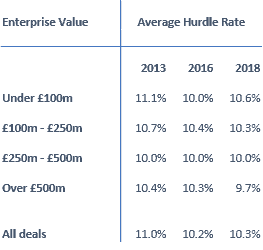Trends in management terms – hurdle rates

What terms are currently being offered to management teams by financial investors and how have these trended over time? Do they differ depending upon deal size or deal type?
Using data collected from financial investor proposals to management teams covering the six-year period ending December 2018 we have analysed some of the key metrics and trends.
The data over this period comprises over 150 different proposals put to management teams from some 100+ different financial investors, ranging from lower mid-market primary management buy-outs to large cap tertiary auctions. While the businesses are mainly UK or European based, many are global businesses and they are from all sectors of the economy with financial investors from the UK, North America, Europe and the Far East.
In this article we look at hurdle rates which we last reviewed 3 three years ago and how they differ across deal size and how and why they have changed over time.
What are they and why are they used?
Hurdle rates in UK/European structures are typically loan note yields or preference share coupons attaching to the institutional investment in the capital structure, which accrue over the life cycle of the investment and on an exit event are paid out of proceeds ahead of any equity entitlement.
Apart from providing investors with a fixed return on their investment (in addition to the variable equity return) they protect an investor’s downside return, offering a minimum return.
Hurdle rates interact with sweet equity allocations with lower hurdle rates typically being proposed with lower sweet equity allocations. In US structures, hurdle rates are typically linked to multiples of the investor’s investment, but act in the same way in setting a hurdle before the equity comes into value.
In simple terms for management teams, who hold relatively low levels of institutional money, the higher the hurdle rate the lower the equity value is likely to be on an exit event.

Average hurdle rates have fallen consistently since the banking crash in 2008 and this trend has continued, albeit at a slowing rate, with 2018 indicating a tailoring off with the average hurdle rate.
The vast majority of hurdle rates proposed on transactions are 10% with outliers of 8% and 12% impacting the average.
The lowest hurdle rate was 8% with the highest an eye watering 17%. Lower hurdle rates are often in asset backed businesses such as infrastructure deals, or the very large transactions where it is accepted that the early stage growth rates are not as likely.
The majority of hurdle rates compound annually with some outliers on semi-annual compounding.
How do they vary by deal size?
The average hurdle rate across all deal sizes has largely fallen over time, with deals in the under £100m EV range and over £500m showing the largest decreases over time.
The average hurdle rate for larger transactions is nearly a point lower than the smaller sub £100m EV deals reflecting competition for larger transactions and the lower growth rates expected in larger businesses.

In Summary
The trends for management teams are positive with hurdle rates ranking ahead of the equity at historically low levels without a squeeze on lower sweet equity allocations.
